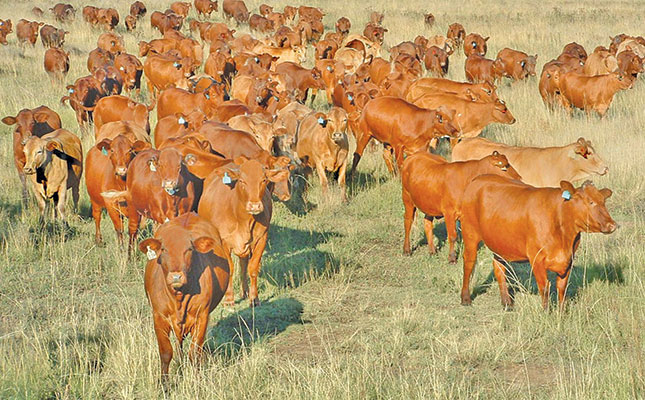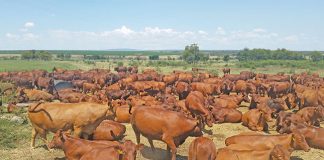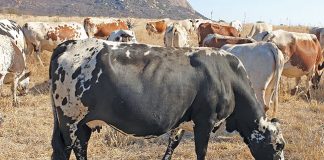
Photo: FW Archive
Two factors are crucial to the success of estimated breeding values: correct (and honest) recording, and complete recording. Management practices can influence the accuracy of breeding values in terms of animal recording, parentage recording, performance recording, contemporary groups, and genetic linkages.
Animal recording
The details of the animal are essential for assigning it to the correct contemporary group (sex and birth season) and for applying the accurate age-correction factors in the genetic evaluation (BLUP) model. To obtain these details, carry out the following:
- Ensure that all calves are recorded at birth, and
- keep the reproduction records of cows complete.
- Ensure that all animal details, particularly birth date and sex, are recorded correctly.
- Ensure that birth notifications for all calves are submitted on time.
Parentage recording
Assigning the correct parents to a calf is one of the most important factors for genetic evaluation, as this is the basis of all genetic relationships of that particular animal. Recording of incorrect parentage compromises the accuracy of the animal’s breeding values, as well as those of all its relatives.
The more performance-tested relatives of an animal that are included in the BLUP analysis, the more accurate its breeding value predictions will be. If possible, make use of single-sire matings or, if multiple sires are used, confirm parentage via DNA analysis. Record mating groups correctly and ensure that these records are kept in a safe place.
Record artificial insemination (AI) sires correctly from the semen straws. If AI is followed with mating within 28 days of the last AI date, use DNA analysis to confirm parentage.
For all calves born from embryo transplants, confirm parentage via DNA analysis.
Mark calves and record their particulars, such as dam and sire, as soon as possible after birth.
Performance recording
In general, guidelines on animal-performance recording are aimed at identifying, as far as possible, environmental (non-genetic) effects that may have influenced the performance of a specific animal.
Ensure that all selected traits are recorded for the group, as the recording of a specific trait will enhance the accuracy of other correlated traits. For example, the recording of yearling weight will increase the accuracy of weaning weight, and vice versa.
Ensure the weighing/measuring instrument is in good working order and calibrated correctly.
Weighing procedures:
- Weigh all animals of a contemporary group on the same day, if possible, or on consecutive days. In other words, avoid weighing them on different days that are far apart. This will eliminate factors that may change from one weighing date to the next, such as the quality and/or quantity of pastures.
- Weigh all animals after food and water has been withheld from them for 12 hours. This practice will reduce weight variation caused by gut fill.
- Ensure that an animal is correctly identified, preferably before it is weighed.
- Make certain that the weight is correctly observed and recorded.
- When weighing a group of animals, reset the scale to zero each time you weigh a different animal, and use regular intervals.
- Compare the recorded weight with (recent) previous weights of the animal. If any discrepancy is observed, weigh the animal again to make sure the correct weight is recorded.
- Check for reading/writing errors when the recorded data is transferred to your computer or input documents.
Contemporary groups
One of the most important factors in animal recording for genetic evaluation purposes is properly defined contemporary groups. Poorly or incorrectly defined groups are probably the most important source of low prediction accuracy in genetic evaluations.
A contemporary group can be defined as those animals born in the same year/season (similar age range), in the same location (herd or farm), of the same sex, and managed
alike from birth to the time of measurement (the same feeding regime, date of measurement, and so on).
Of these factors, poorly or wrongly defined seasons, extended age ranges, restructured contemporary groups due to animals moving from one group to another, and animals assigned to the wrong management groups are the most common sources of poorly defined contemporary groups.
In general, these guidelines are aimed at ensuring that any contemporary group is defined in such a way that all (or at least all significant) environmental effects, except those that are corrected for in the evaluation model, such as dam age, are the same for all animals in a particular group.
This, combined with good genetic linkages between groups, will ensure that BLUP can effectively separate genetic and environmental effects within particular groups.
Grouping animals
The grouping of animals is basically done in two ways, namely:
- Automatic groupings, for example, breed, herd, birth year and season, sex, birth status (single/twins), and so on; and
- Farmer-supplied or -influenced management groupings, such as weighing date, calf age, rearing status and feeding status.
Farmers have little control over the aspects of automatic grouping:
- Herd – only calves bred and weighed in the same herd or locality can be compared. The locality (farm or test centre) where a group (herd or test group) of animals is kept at a specific time is called the ‘keeper’.
- If a producer has more than one farm where the animals (within the breed) are managed as independent, separate herds, and/or the climate, veld type, management, or quantity and/or quality of forage differ substantially, these farms should preferably be handled as different herds or keepers.
- On the other hand, when animals owned by different farmers are run and managed together, they can be handled as one herd or keeper in order to expand the contemporary groups.
- Birth year and season – only calves born in the same calving year and season can be compared. The National Beef Recording and Improvement Scheme allows for a maximum variation in birth dates of 100 days.
- Sex – only calves of the same sex should be compared.
- Birth status (single/twin) – only calves of the same birth status can be compared, and singletons should not be compared with twins. While twins can be compared with other twins that had the same rearing status, and so on, the low occurrence of twins usually doesn’t facilitate this.
- Calves born as a result of embryo transfer – these calves should not be compared with those that are suckling their own dams. The assigning of animals to management groups is obviously the area where the farmer can play a major role in optimising the genetic evaluations of his or her herd. All calves assigned to different rearing and/or feeding status groups within a particular test are evaluated separately.
It is important to remember the following when assigning animals to groups:
- Keep the groups large yet homogeneous.
- Don’t mix or split the groups up unnecessarily.
- The most obvious management practice is to use one short breeding season (or two, depending on your circumstances) instead of running the bulls with the cows for extended periods or even the entire year.
- Breeding seasons should last for a maximum of 90 days; however, shorter periods are preferable, such as 75 or even 63 days. This will ensure large contemporary groups based on the birth dates of calves.
- With regard to birthweights, fill in the Birth Weight Group Code field when recording births. This will help to ensure that the calves are linked to the correct group in terms of the estimation of birthweight EBVs.
- Ensure that all animals in a particular group fit into the age limits for that phase/recording. For example, they must be between 151 and 250 days old for the recording of weaning weights.
- Try to weigh all calves in a particular group on the same day or, if this isn’t possible, within the same week.
- Ensure that all animals in a particular group are recorded. To put it another way, no selective recording should be done. For example, don’t only record the birthweights of big calves or those that had difficult births, as recordings of this nature hold no value and may actually be misleading.
- Ensure that all animals in the group have the same treatment from birth to a particular weighing.
- Animals weighed at 12 and 18 months should, as far as possible, be placed in the same groups as they were at weaning (except if some animals’ management and/or feeding differed or they were bought in, in which case those animals should be grouped separately).
- The reasons for this are that bias due to culling or selection at weaning, and bias due to management and nutrition at weaning, are taken into account.
- All calves that were fed concentrates before weaning should be assigned to a separate feeding status group, even for post-weaning weights.
- Bulls sent to central performance tests (Phase C) should be evaluated with their contemporaries for weaning weights.
- Bulls tested after being weaned on concentrates, such as in Phase C tests, should not be grouped with pasture-raised bulls for weights at 12 and/or 18 months.
- Calves from first-parity cows should not be evaluated in separate contemporary groups to those from older cows, unless the first-parity cows received preferential nutrition and/or management, in which case it should be indicated as such.
- Weigh all calves at weaning and, as far as possible, don’t mix calves of different weaning groups for any post-weaning weights.
- Rotate groups across camps to minimise the camp effect on any particular group. If this isn’t possible, and the quality and/ or quantity of the pastures in different camps vary significantly, assign different feeding status codes to these groups.
- Assign the appropriate rearing status codes to all calves, such as that for calves raised by foster dams, and so on.
- Allocate the appropriate remark codes to all ‘abnormal’ calves, including those that are sick or injured.
- Participation in competitive showing of cattle is discouraged, because such animals receive preferential feeding and management, and should therefore be evaluated in separate groups. This applies not only to young animals, but also to calves whose dams are showed.
- If bulls are to be castrated, try to postpone this until their weaning weights have been recorded.
Genetic linkages
Genetic linkages enable BLUP to benchmark the genetic merit of animals from different herds, birth years, seasons and management (rearing and feeding) groups. By far, sires contribute the most to genetic linkages.
A link sire can be defined as a sire having performance-recorded progeny in other herds, years, seasons and/or management groups. If, for example, all calves in Group 1 are from sire A and all calves in Group 2 are from sire B (and the cows from group A are not related to those in group B), benchmarking the genetic merit of these two groups will be impossible.
Genetic linkages determine the ‘effective progeny’ of a sire in a contemporary group. Here are tips to improve on these linkages:
- Utilise widely used AI bulls. This is by far the easiest and most effective way to establish genetic linkages.
- Establish a system of exchanging bulls between herds. This is particularly helpful when determining genetic linkages between herds if AI isn’t used.
- Use more than one bull per season in your herd, including at least one AI bull.
- Have calves from as many sires as possible (at least two) in each management group. Where all calves in a specific contemporary group are the progeny of one sire, their information will be of no value when it comes to calculating their sire’s breeding values. The reason for this is that the number of effective progeny for that particular sire is zero, which implies that the genetic (sire) effect cannot be separated effectively from the environmental (contemporary group) effect. It’s a common practice in some herds to mate a specific sire only with heifers. If all calves from such a sire are evaluated in a separate contemporary group, the number of effective progeny from this sire is zero.
- Try to have a mix of AI bulls’ and own bulls’ calves in each management group.
- Avoid replacing all bulls in the same year. If you have to, at least attempt to use some of the previous year’s AI bulls.
- Buy bulls (and female animals) from performance-recorded herds.
- After the mating season has ended, run cows in one big group. If this is not possible, regroup the cows to ensure that those from at least two (preferably more) mating groups are represented in each new cow group. You should also avoid keeping the mating groups intact and separate them once the season has ended.
- Avoid mating the same group of cows to the same bull year after year. Instead, regroup them on a regular basis. The best time for this is at weaning to ensure that they are familiar with their new group before they start calving.
- Ensure that the extended pedigrees of imported semen/bulls are recorded on the Integrated Registration and Genetic Information System.
- When entering bulls for Phase C testing, send at least three animals from the same weaning group. These bulls should be the progeny of at least two sires, at least one of which is a link sire.
Email Dr Ben Greyling at [email protected].










